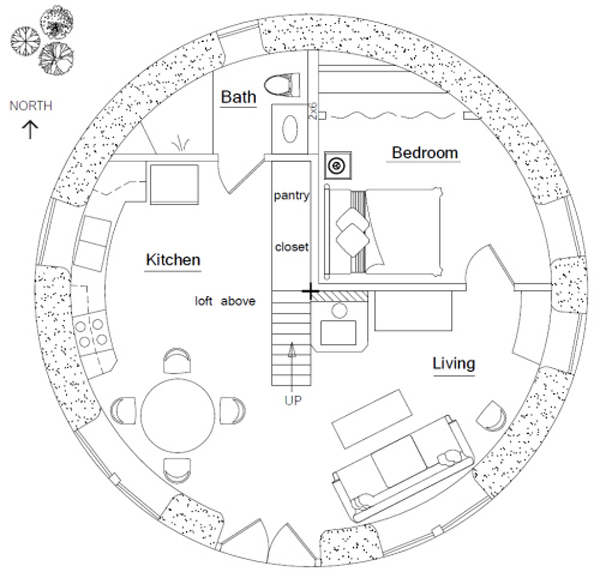
This is a new house design that I just thought up yesterday. Basically, it’s a dome shape that’s cut off at the 8’ height level with a roof on top. The main benefit is to replace the harder to build top portion of the dome with a faster, easier to construct roof that will protect the earthbag walls. This is a good design for earthquake regions like Nepal that get a lot of rain. Lightweight roofs are preferable to heavy roofs in seismic areas, plus domes will have moisture problems and mold in rainy climates. Metal roofing would be a good choice for this design.
The wider base of the walls naturally stabilizes the building, much like a person whose legs are spread apart is harder to push over than someone standing with their feet together. Nepalis love storage space above their homes for drying and storing food. The attic space could also be used for extra sleeping or living space. Also, a roof can more easily be insulated than a dome. This is important since Nepal has cold winters.
All of my house designs can be viewed at Earthbag House Plans. Note how the Hobbit design is popular so I’ve shown how a variety of roofs can be used.

The roof and building are covered in the “floridadomehome[DOT]com. Menu for the conversion is “conversion from dome to hobbit … 2015”
It’s a challenge working the blog from an iPad but perhaps Owen will post some photos for you. I tried.
I am interested to find the cost in India.
My earthbag roundhouse cost $2,100 with modern plumbing and electrical. Later we upgraded to more durable MCR roofing for another $1,000 or so.
http://www.instructables.com/id/How-to-Build-an-Earthbag-Roundhouse/p
This half dome is larger so the total cost in India would probably be $4,000 – 5,000 or so. Keep in mind there are many ways to save money. You could use lots of recycled materials like wood, bamboo, hardware, etc. The windows could be jali block: https://naturalbuildingblog.siterubix.com/glassless-windows/
See How to Build Dirt Cheap Houses:
http://www.instructables.com/id/How-to-Build-Dirt-Cheap-Houses/
I converted the dome to a “hobbit” design, a weather justified decision. Metal roof with sky-light, wood burning stove and air vent in the roof. Piping for water heating too. More space inside with 4 small windows and two arched doorways for future extension which will be plastered in temporarily this month. Bags were cement stabilized. Rendering will be building sand/cement/lime mix. Torrential rain will still get to one side despite the overhang of the roof.
The plans will be posted for anybody that wants them, once construction is completed.
I will post some updated photos to the blog soon if you want to take a look.
Mike
Thanks for the update. We’re always happy to look at what people are doing.
Thanks much Mike for the details. I look forward to your blog photos.
I imagine the Air Vents can be problematic in blowing rain.
The air vent you mentioned is probably static, whereas the air vent I envisioned, rather than the Air Scoop, is one that rotates with the wind and sucks air out of the building.
Ron Ali
Oh, great Owen, this just what had evolved in my head for our intended home in Indonesia, mainly because of constant humidity..! Along with Skylights over the Kitchen and Bathroom, I had envisioned a Reciprical Roof with a Wind Scoop in the center..! Any thoughts on the latter..?
Sincerely, Ron Ali
Improved ventilation is another benefit. Thanks for mentioning it. You can only make so many windows in a dome before the structure is weakened. Reciprocal roofs are good. Make sure it’s securely fastened in earthquake areas. Wind scoops are for deserts. No need in Indonesia. Or maybe you’re talking about a simple vent in the roof top? That is a good idea. We did this on our roundhouse when we changed from thatched roofing to MCR roofing tiles.
I showed this to my latest group of workshop attendees yesterday and they said they liked it. I think this design will be much more culturally accepted than domes. (Just recently an NGO build a dome for a family in Nepal and they refused to live in it.) Also, rainwater can be collected off the roof. You could add a skylight on top.